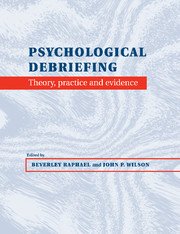Book contents
- Frontmatter
- Contents
- List of contributors
- Introduction and overview: Key issues in the conceptualization of debriefing
- Part I Key conceptual framework of debriefing
- Part II Debriefing: models, research and practice
- 5 Critical Incident Stress Management and Critical Incident Stress debriefings: evolutions, effects and outcomes
- 6 Debriefing with emergency services: Critical Incident Stress Management
- 7 Debriefing and body recovery: war grave soldiers
- 8 Debriefing and body recovery: police in a civilian disaster
- 9 Debriefing after massive road trauma: perceptions and outcomes
- 10 Debriefing and motor vehicle accidents: interventions and outcomes
- 11 Debriefing with service personnel in war and peace roles: experience and outcomes
- 12 Debriefing post disaster: follow-up after a major earthquake
- 13 Debriefing after disaster
- 14 Children and debriefing: theory, interventions and outcomes
- 15 Debriefing adolescents after critical life events
- Part III Adaptations of debriefing models
- Part IV Debriefing overview and future directions
- Conclusion: debriefing – science, belief and wisdom
- Index
9 - Debriefing after massive road trauma: perceptions and outcomes
from Part II - Debriefing: models, research and practice
Published online by Cambridge University Press: 06 January 2010
- Frontmatter
- Contents
- List of contributors
- Introduction and overview: Key issues in the conceptualization of debriefing
- Part I Key conceptual framework of debriefing
- Part II Debriefing: models, research and practice
- 5 Critical Incident Stress Management and Critical Incident Stress debriefings: evolutions, effects and outcomes
- 6 Debriefing with emergency services: Critical Incident Stress Management
- 7 Debriefing and body recovery: war grave soldiers
- 8 Debriefing and body recovery: police in a civilian disaster
- 9 Debriefing after massive road trauma: perceptions and outcomes
- 10 Debriefing and motor vehicle accidents: interventions and outcomes
- 11 Debriefing with service personnel in war and peace roles: experience and outcomes
- 12 Debriefing post disaster: follow-up after a major earthquake
- 13 Debriefing after disaster
- 14 Children and debriefing: theory, interventions and outcomes
- 15 Debriefing adolescents after critical life events
- Part III Adaptations of debriefing models
- Part IV Debriefing overview and future directions
- Conclusion: debriefing – science, belief and wisdom
- Index
Summary
EDITORIAL COMMENTS
Massive road trauma such as the crash of a tourist or school bus brings widespread physical and psychological trauma. These effects are experienced by survivors (injured and uninjured), bereaved family members of those who die, rescue and emergency personnel, and the communities in which they occur.
Watts reviews studies in this field, and describes his own research findings, which cover three major incidents of this kind in Australia. His and other findings are clear about the substantial and often long-lasting morbidity that may follow. With each of the groups involved there are identified needs for psychological assistance and Watts reviews what is known about debriefing, which has been the most frequently applied prevention and support measure. The findings of this work make clear that debriefing is not appropriate for survivors or the bereaved, as it may add to their distress. Nevertheless group-based support focussing on information and sharing of concern may be helpful. Such groups may arise naturally, or be drawn together and may represent the grouping of those affected who were a prior established group (e.g. class of school children, club group of the elderly). In any case this is not a traditional debriefing but may be classified, Watts suggests, as an ‘adaptive’ debriefing in that it has information, shared understandings of what has occurred and mutual support for planning and needs as its role.
Keywords
- Type
- Chapter
- Information
- Psychological DebriefingTheory, Practice and Evidence, pp. 131 - 144Publisher: Cambridge University PressPrint publication year: 2000
- 1
- Cited by



